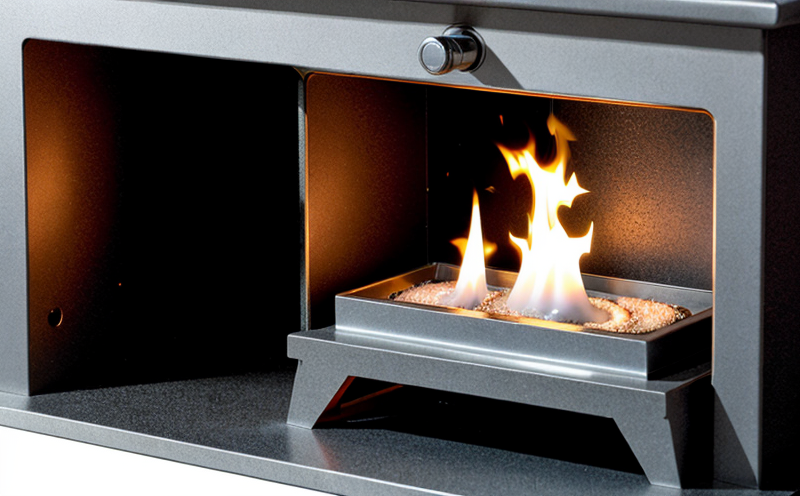Surface Flame Spread Testing of Laboratory Materials
In fire safety testing, Surface Flame Spread (SFS) is a critical parameter that assesses how quickly and intensely a material will ignite and spread flame. This test is particularly important for materials used in laboratories, where combustibility can pose significant risks if not properly managed.
The purpose of this service is to evaluate the flame spread characteristics of laboratory materials under controlled conditions. This helps ensure that materials meet relevant fire safety standards and guidelines. By understanding how these materials behave when exposed to a flame source, we can prevent potential hazards in laboratory settings and beyond. Properly conducted SFS testing provides essential data for quality control, product development, and regulatory compliance.
The test involves exposing the material sample to a standard flame source and measuring its ability to spread or resist spreading of that flame. The results provide insights into the ignition behavior and flame propagation characteristics of different materials. This information is crucial for selecting appropriate materials in fire-prone environments like laboratories, where even small sparks can lead to significant incidents.
Surface Flame Spread Testing aligns with various international standards such as ASTM E84-21, ISO 6702:2005, and EN 13501-1. These standards outline the procedures for conducting the tests, ensuring consistency across different laboratories around the world.
The testing process typically involves preparing a sample of the material according to specified dimensions and conditions. The sample is then placed in a specially designed test chamber where it is exposed to a standardized flame source. Observers carefully measure the distance the flame spreads over time, recording both horizontal and vertical spread rates. Additional parameters such as smoke production and heat release can also be measured.
The results of these tests are used by quality managers, compliance officers, R&D engineers, and procurement teams to make informed decisions about material selection and design modifications. For instance, manufacturers can use the findings from SFS testing to improve fire resistance in their products or to ensure that new materials comply with industry standards.
The importance of Surface Flame Spread Testing extends beyond just laboratory environments. It also plays a key role in ensuring safety in other settings where flammable materials are used, such as manufacturing plants and research facilities. By identifying potential risks early on through rigorous testing, we can enhance overall fire safety protocols and minimize the likelihood of accidents.
Why It Matters
The significance of Surface Flame Spread Testing cannot be overstated in today's increasingly stringent regulatory landscape. Regulatory bodies around the world have established strict requirements for materials used in various industries, including laboratories and research facilities. Compliance with these regulations is not only necessary but also essential for maintaining a safe working environment.
In laboratories, where researchers often handle flammable chemicals and other hazardous substances, fire safety should be a top priority. Ignition of even small amounts of material can quickly escalate into larger fires if proper precautions are not taken. By conducting Surface Flame Spread Testing, organizations demonstrate their commitment to adhering to these regulations and protecting the well-being of everyone involved.
The test results provide valuable information that helps in making informed decisions regarding material selection and design improvements. For instance, manufacturers can use the findings from SFS testing to enhance fire resistance properties or ensure compliance with relevant standards like ASTM E84-21, ISO 6702:2005, and EN 13501-1.
Moreover, Surface Flame Spread Testing contributes significantly towards reducing the risk of accidents in laboratories. By identifying potentially hazardous materials early on through rigorous testing procedures, organizations can implement effective fire safety measures to prevent incidents from occurring. This proactive approach ensures that both personnel and facilities remain secure against the threat of fires.
Finally, conducting Surface Flame Spread Testing aligns with broader goals related to sustainability and environmental responsibility. By selecting materials that perform well in flame spread tests, organizations contribute towards reducing greenhouse gas emissions associated with fire-related incidents. This not only promotes safer working conditions but also helps mitigate the negative impacts on our environment.
Scope and Methodology
| Parameter | Description |
|---|---|
| Flame Source | A standardized flame source is used to expose the material sample. |
| Sample Preparation | The sample must be prepared according to specified dimensions and conditions. |
| Test Chamber | The test takes place in a specially designed chamber that maintains consistent environmental conditions. |
| Measurement Parameters | Distance the flame spreads, horizontal and vertical spread rates, smoke production, heat release. |
The Surface Flame Spread Testing service follows strict protocols outlined in international standards such as ASTM E84-21, ISO 6702:2005, and EN 13501-1. These standards ensure that the testing process is consistent across different laboratories worldwide. The test begins by preparing a sample of the material according to specified dimensions and conditions. Once ready, the sample is placed in a specially designed test chamber where it is exposed to a standardized flame source.
Observers carefully measure the distance the flame spreads over time, recording both horizontal and vertical spread rates. Additional parameters such as smoke production and heat release can also be measured during this process. The results provide valuable insights into how well the material resists ignition and limits its spread once ignited. This information is crucial for ensuring that materials used in laboratories meet relevant fire safety standards.
Use Cases and Application Examples
| Use Case | Description |
|---|---|
| Laboratory Safety | Evaluating materials used in chemical storage and handling to ensure they do not pose a fire hazard. |
| Product Development | Identifying suitable materials for new product designs that meet stringent fire safety requirements. |
| Regulatory Compliance | Ensuring compliance with local and international standards related to flammable materials used in laboratories. |
| R&D Optimization | Optimizing material properties through iterative testing processes until desired flame spread characteristics are achieved. |





